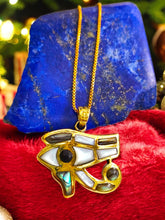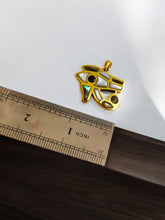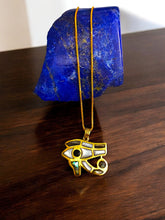
Discover the timeless power of ancient symbolism with our Gold Large Eye of Horus Pendant, a striking piece of Egyptian revival jewelry. Carefully handmade with a unique vintage finish, this divine minimalist pendant is more than just a beautiful accessory—it's a meaningful talisman rich in spiritual energy and protective symbolism.
Crafted from a durable and radiant alloy of 5% gold and 95% brass, this pendant is designed to last while maintaining a luxurious glow. At the heart of the Eye lies a mesmerizing Mother of Pearl inlay, which seems to glow from within, its colors shifting and dancing with the light depending on the angle—just like the abalone detailing, which adds depth and a spectrum of iridescent hues.
This pendant is a faithful replica of ancient tomb drawings, capturing the mystique and sacred artistry of ancient Egyptian culture. The Eye of Horus represents*protection, healing, and wisdom, making it not just an ornament, but a source of inspiration and strength. It is suitable as a gift for both men and women, fitting any chain up to 5mm thickness—perfect for adding a meaningful touch to your everyday wear or spiritual practice.
To maintain its beauty, gently wipe with a soft cloth after wear and store in a dry place. Avoid exposure to water, perfumes, and harsh chemicals to preserve the finish and the integrity of the mother of pearl and abalone inlays.
Historical Glance:
The Eye of Horus, also known as the Wedjat, was a symbol of royal power, health, and protection in ancient Egypt. It was often depicted in tombs, amulets, and artworks to guard the soul in the afterlife. This pendant echoes those sacred designs, bringing a piece of history into your hands.
Thank you for visiting our shop. We’re honored to share our handcrafted creations with you. If you have any questions or need further assistance, please don’t hesitate to reach out—we’re here to help!













